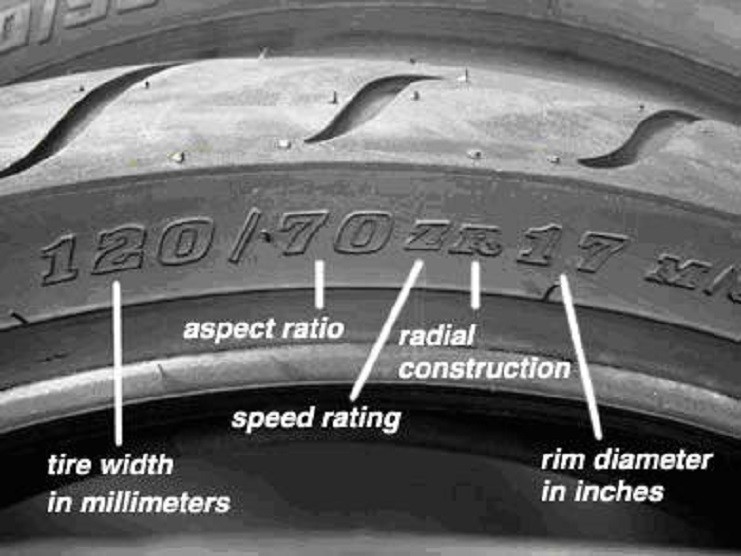Tire size can be confusing. Some numbers on the sidewall are listed in millimeters while others are inches. Plus, the right size for your car, truck, or trailer can differ depending on where and how you drive.
You can see your original equipment tire size in your owner’s manual or on the placard generally located on the driver’s side door jam. This is the sizing recommended by the vehicle manufacturer.
If you’re interested in switching out your tires for a different look or performance, a good place to start is the numbers and other indicators on your existing tires’ sidewall. Next, have a tire professional help you determine a tire size range that will fit your vehicle and driving needs.
Here’s what those numbers and indicators on the sidewall indicate and how to understand them:
A: TIRE TYPE The first letter in the code tells you what class of tire it is.
P stands for passenger vehicle tire. P-class tires include cars, SUVs, crossovers, minivans and smaller pickup trucks.
LT means light truck tire, designed for vehicles that are capable of carrying heavy loads, towing trailers, or for those looking for an extra heavy duty option. These are often equipped on three-quarter or 1 ton trucks and SUVs.
ST stands for Special Trailer. These tire sizes are meant for trailers, including fifth wheels and other travel trailers, as well as boat and utility trailers.
If there’s no letter before the first number, you have a metric tire most commonly referred to as European size. It’s also measured in millimeters but may have a different load capacity than a P or LT tire.
B: TIRE WIDTH The three-digit number following the letter is the tire’s width (from side to side, looking at the tire head on) in millimeters. This may also be referred to as the section width.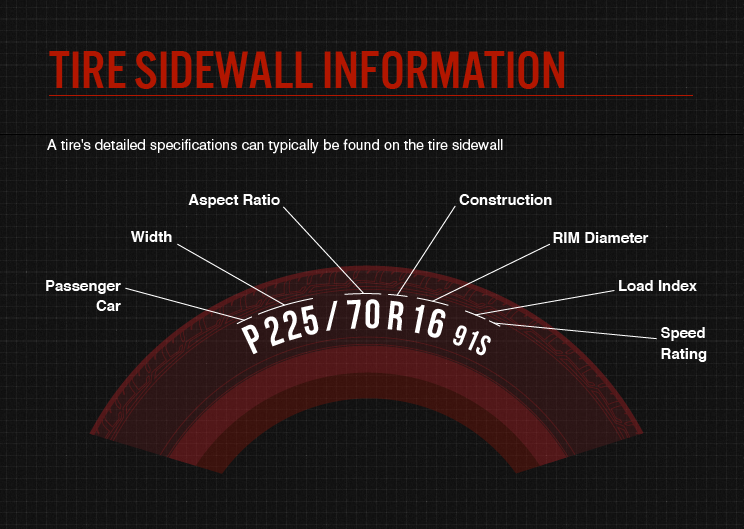
C: ASPECT RATIO The forward slash separates the tire width number from the two-digit aspect ratio. The bigger the aspect ratio, the higher/taller the tire’s sidewall, or “profile” as it’s sometimes called.
The aspect ratio is indicated on the tire sidewall as a percentage. It’s the height of the sidewall measured from wheel rim to top of the tread, expressed as a percentage of tire width.
In this example, the aspect ratio is 65, meaning the sidewall is 65 percent as high as the tire is wide. To get the sidewall height, take the tire width of 215 mm and convert it to inches (8.46). Then multiply this by 65% (.65). This gives you an answer of 5.5, the sidewall height in inches.
D: CONSTRUCTION TYPE This single letter tells you about the internal construction of the tire.
R is for radial tires, the industry standard for most tires today. They have better road grip, lower rolling resistance for better gas mileage, ride comfort and durability than previous generations of tires.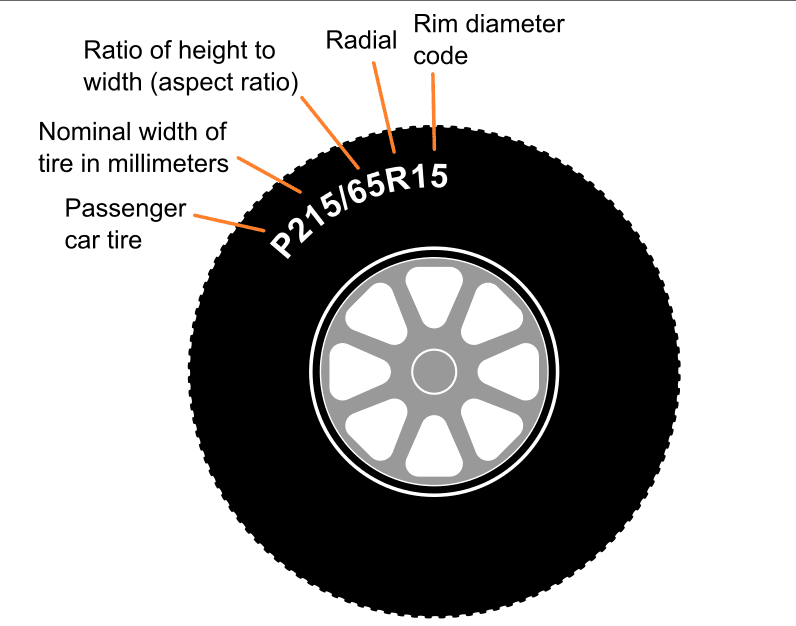 In a radial tire, the plies — layers of strong cords made of a blend of polyester, steel and fabric and coated with rubber — are laid perpendicular to the direction of travel.
In a radial tire, the plies — layers of strong cords made of a blend of polyester, steel and fabric and coated with rubber — are laid perpendicular to the direction of travel.
D is for tires built with diagonal (crisscrossed) plies, called bias-constructed tires. They are also called conventional, x-ply, or cross-ply tires. Some motorcycle and trailer tires still use this internal construction.
Some run-flat tires are identified with an F followed by the type of internal construction.
E: WHEEL DIAMETER This two-digit number specifies wheel diameter in inches. It’s the distance between the two bead seat areas (where a tire gets tightly sealed onto the wheel).
F: LOAD INDEX The two-digit or three-digit number that follows the gap specifies tire load index. The load index symbol indicates how much weight a tire can support, based on the following standard chart. In our example, the load index is 89, which indicates the tire has a load capacity of 1,279 pounds, when inflated to the tire’s maximum air pressure rating.
G: SPEED RATING The last letter is the tire speed rating. This indicates the top speed it’s safe to travel at for a sustained amount of time. A tire with a higher speed rating can handle heat better and provide more control at faster speeds. The maximum operating speed of a vehicle is no more than the lowest speed rating of all tires mounted on the vehicle. (Of course, you should always abide by speed limits for safer driving.) Speed rating is usually, but not always, a single letter (see the chart).
Below you will find several charts that will help you understand tire sizing numbers, including a load index chart and speed rating chart.
A tire size calculator is a quick way to see whether the tire size you’re considering will likely fit your car, SUV, sports car, light truck or crossover.
But remember that is only an estimate. It’s important to stay within the sizing tolerances of your vehicle.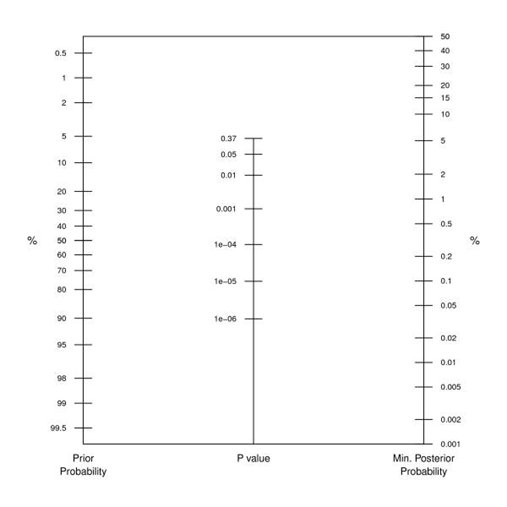 Tires that are the wrong size could cause some pull in the steering wheel, rub against the suspension or body of your vehicle, reduce clearance on hills, or result in a stiffer or noisier ride.
Tires that are the wrong size could cause some pull in the steering wheel, rub against the suspension or body of your vehicle, reduce clearance on hills, or result in a stiffer or noisier ride.
If you’re considering mounting a different tire size on your vehicle, check with a tire expert. Find out whether the tires and wheels you have your eye on are the right fit for your vehicle’s suspension, gearing, and bodywork. And ask how any differences in revolutions per mile, tire speed, load index, and speed rating will affect your ride quality and vehicle performance.
See how new tires and rims will look on your car or truck using our Virtual Wheels simulator, available at any Les Schwab.
Find Your Store
When shopping for tires online, you’ll notice the terms load index, load range, and speed rating included within the technical specifications. (You can find these numbers and letters on your existing tires, located after the size of the tire.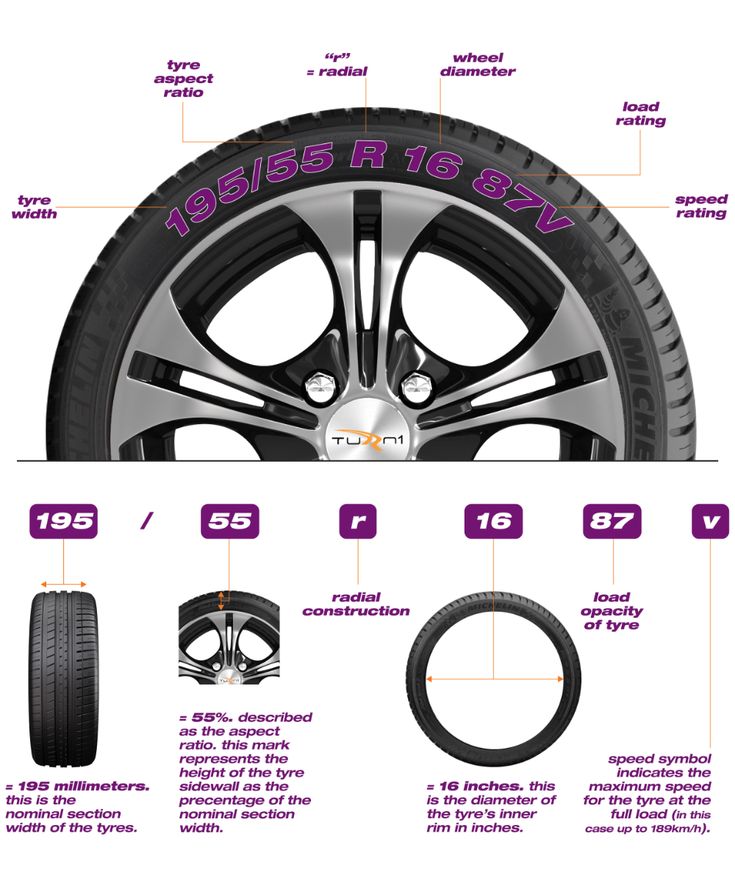 ) Understanding the meaning of load index and load range can help you find the right tire for your vehicle and your needs. As always, the experts at Les Schwab can answer all of your questions about what tires are right for you, but in this quick article, we’ll cover some of the basics of these indicators.
) Understanding the meaning of load index and load range can help you find the right tire for your vehicle and your needs. As always, the experts at Les Schwab can answer all of your questions about what tires are right for you, but in this quick article, we’ll cover some of the basics of these indicators.
Find A Store
The load index of a tire is a number that correlates to the maximum safe carrying capacity of the tire when it’s inflated to its maximum pressure. Higher load index ratings mean your tires will be able to handle a heavier load. In this example, there are two numbers. The higher number (load index) is for single rear-wheel applications. The lower number is for dual-wheel applications. This indicates its load-carrying capacity when inflated to its maximum pressure. Remember, air pressure is what carries the load in a tire. You can find each tire’s carrying capacity with the chart below.
| LOAD INDEX |
LOAD (lbs) |
LOAD INDEX |
LOAD (lbs) |
LOAD INDEX |
LOAD (lbs) |
|---|---|---|---|---|---|
| 65 | 639 | 94 | 1477 | 123 | 3417 |
| 66 | 661 | 95 | 1521 | 124 | 3527 |
| 67 | 677 | 96 | 1565 | 125 | 3638 |
| 68 | 694 | 97 | 1609 | 126 | 3748 |
| 69 | 716 | 98 | 1653 | 127 | 3858 |
| 70 | 739 | 99 | 1709 | 128 | 3968 |
| 71 | 761 | 100 | 1764 | 129 | 4079 |
| 72 | 783 | 101 | 1819 | 130 | 4189 |
| 73 | 805 | 102 | 1874 | 131 | 4299 |
| 74 | 827 | 103 | 1929 | 132 | 4409 |
| 75 | 853 | 104 | 1984 | 133 | 4541 |
| 76 | 882 | 105 | 2039 | 134 | 4674 |
| 77 | 908 | 106 | 2094 | 135 | 4806 |
| 78 | 937 | 107 | 2149 | 136 | 4938 |
| 79 | 963 | 108 | 2205 | 137 | 5071 |
| 80 | 992 | 109 | 2271 | 138 | 5203 |
| 81 | 1019 | 110 | 2337 | 139 | 5357 |
| 82 | 1047 | 111 | 2403 | 140 | 5512 |
| 83 | 1074 | 112 | 2469 | 141 | 5677 |
| 84 | 1102 | 113 | 2535 | 142 | 5842 |
| 85 | 1135 | 114 | 2601 | 143 | 6008 |
| 86 | 1168 | 115 | 2679 | 144 | 6173 |
| 87 | 1201 | 116 | 2756 | 145 | 6393 |
| 88 | 1235 | 117 | 2833 | 146 | 6614 |
| 89 | 1279 | 118 | 2910 | 147 | 6779 |
| 90 | 1323 | 119 | 2998 | 148 | 6944 |
| 91 | 1356 | 120 | 3086 | 149 | 7165 |
| 92 | 1389 | 121 | 3197 | 150 | 7385 |
| 93 | 1433 | 122 | 3307 |
| LOAD INDEX | LOAD (lbs) |
|---|---|
| 65 | 639 |
| 66 | 661 |
| 67 | 677 |
| 68 | 694 |
| 69 | 716 |
| 70 | 739 |
| 71 | 761 |
| 72 | 783 |
| 73 | 805 |
| 74 | 827 |
| 75 | 853 |
| 76 | 882 |
| 77 | 908 |
| 78 | 937 |
| 79 | 963 |
| 80 | 992 |
| 81 | 1019 |
| 82 | 1047 |
| 83 | 1074 |
| 84 | 1102 |
| 85 | 1135 |
| 86 | 1168 |
| 87 | 1201 |
| 88 | 1235 |
| 89 | 1279 |
| 90 | 1323 |
| 91 | 1356 |
| 92 | 1389 |
| 93 | 1433 |
| 94 | 1477 |
| 95 | 1521 |
| 96 | 1565 |
| 97 | 1609 |
| 98 | 1653 |
| 99 | 1709 |
| 100 | 1764 |
| 101 | 1819 |
| 102 | 1874 |
| 103 | 1929 |
| 104 | 1984 |
| 105 | 2039 |
| 106 | 2094 |
| 107 | 2149 |
| 108 | 2205 |
| 109 | 2271 |
| 110 | 2337 |
| 111 | 2403 |
| 112 | 2469 |
| 113 | 2535 |
| 114 | 2601 |
| 115 | 2679 |
| 116 | 2756 |
| 117 | 2833 |
| 118 | 2910 |
| 119 | 2998 |
| 120 | 3086 |
| 121 | 3197 |
| 122 | 3307 |
| 123 | 3417 |
| 124 | 3527 |
| 125 | 3638 |
| 126 | 3748 |
| 127 | 3858 |
| 128 | 3968 |
| 129 | 4079 |
| 130 | 4189 |
| 131 | 4299 |
| 132 | 4409 |
| 133 | 4541 |
| 134 | 4674 |
| 135 | 4806 |
| 136 | 4938 |
| 137 | 5071 |
| 138 | 5203 |
| 139 | 5357 |
| 140 | 5512 |
| 141 | 5677 |
| 142 | 5842 |
| 143 | 6008 |
| 144 | 6173 |
| 145 | 6393 |
| 146 | 6614 |
| 147 | 6779 |
| 148 | 6944 |
| 149 | 7165 |
| 150 | 7385 |
On some tires, you’ll see a load range indicator on the sidewall, as shown here.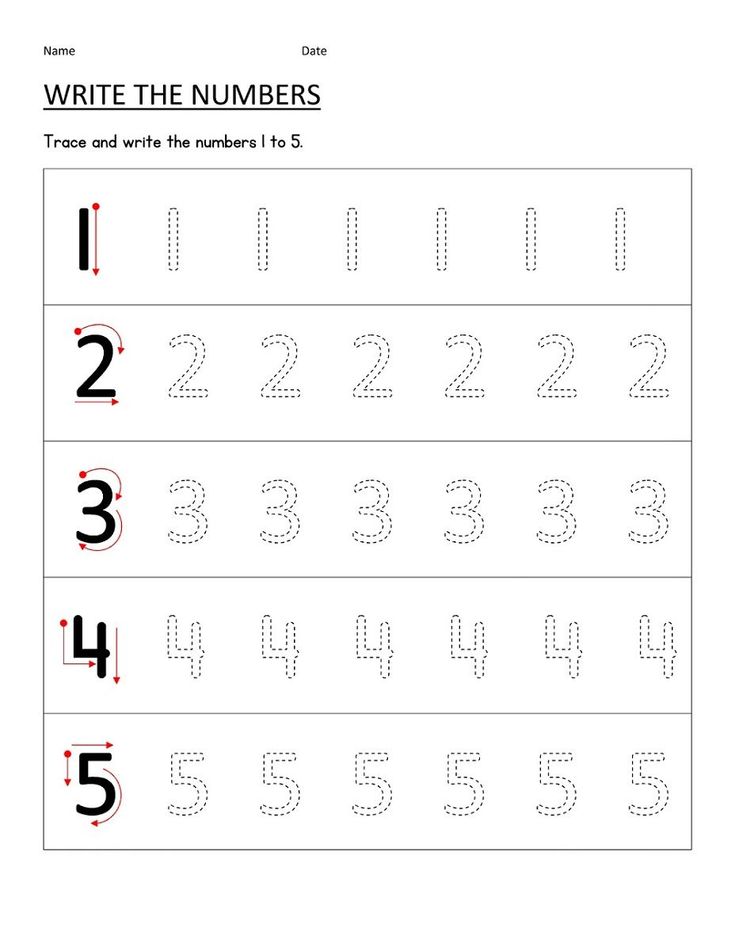 Load Range is an older measure of tire carrying capacity equivalent to
ply rating. The ply rating isn’t directly tied to the number of plies used in construction, so we recommend using Load Index when
appropriate. Load ranges are arranged in alphabetical order starting with the letter “A”. The ply ratings (load range) combined with the tire size tell you the tire load capacity.
Load Range is an older measure of tire carrying capacity equivalent to
ply rating. The ply rating isn’t directly tied to the number of plies used in construction, so we recommend using Load Index when
appropriate. Load ranges are arranged in alphabetical order starting with the letter “A”. The ply ratings (load range) combined with the tire size tell you the tire load capacity.
The load range on replacement tires must meet or exceed the recommendation on your vehicle’s door placard or owner’s manual. It can be higher than recommended but never lower.
| LOAD RANGE | PLY RATING |
|---|---|
| A | 2 |
| B | 4 |
| C | 6 |
| D | 8 |
| E | 10 |
| F | 12 |
Les Schwab Tip: Some cars, including electric vehicles, may require tires with a higher load range due to weight with and without passengers.
If this seems confusing. Don’t worry. The pros at Les Schwab will show you all of your options, including the size, load range, and load index you need for work, weekends, or your daily commute.
The marking of car tires contains all the necessary information about the main parameters of these products, but for people who are not familiar with its decoding, it is very difficult to determine the type of tire and the possibility of its application.
Even if the car owner has not yet encountered the need to establish the basic data indicated on the side of the product, sooner or later the need for this will appear. For this reason, it is better to study in advance the basic principles for decoding the information indicated on the side surface of the tire.
The side of the tire is an excellent marking area. This area is practically not subjected to abrasive wear, so the information is retained unchanged for almost the entire period of operation of the car. The tire manufacturer, brand and size designation can be easily displayed on the rubber surface. The basic data also includes information on the maximum possible load and the speed at which operation can be carried out while maintaining the required level of safety.
The tire manufacturer, brand and size designation can be easily displayed on the rubber surface. The basic data also includes information on the maximum possible load and the speed at which operation can be carried out while maintaining the required level of safety.
On the side there is also information about the possibility of seasonal use of the tire. This parameter is one of the most important, because a violation of the rules for using a tire can result in an accident on the road. The danger lies in the fact that a winter tire in the summer heat acquires increased softness and cannot withstand maximum loads, and a summer tire becomes too hard when operating at low temperatures. For these reasons, the operation of the vehicle cannot provide the required level of safety. The size of the tread and its depth are also different for winter and summer products, so you should pay attention to this parameter in the first place.
Fit size is the most important part of the tire marking that the vehicle owner needs to know for correct fitting.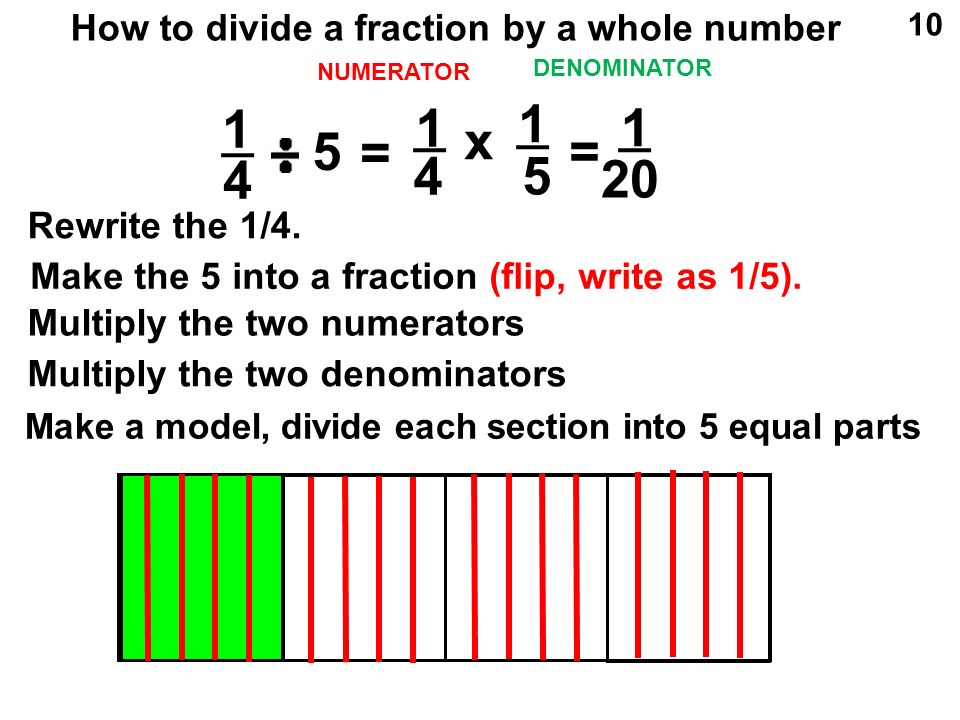 Otherwise, the tire will not be able to be mounted on the rim. Size marking example: 205/55R16 .
Otherwise, the tire will not be able to be mounted on the rim. Size marking example: 205/55R16 .
| 205 | The first number indicates the width of the profile. In this example, this parameter is 205 mm. The profile width is the distance between the outer side surfaces of a tire inflated to operating pressure. |
| 55 | The number 55 following the designation of the profile width indicates the percentage of the height and width of the profile. To calculate the required value, it is enough to multiply the width value by 0.55 to get the desired parameter (205 × 0.55 = 113). Sometimes the percentage between the height and width of the profile is not indicated on the side. In the absence of such a marking on the tire, it is customary to take this value equal to 0.8. |
| R | The symbol R indicates radial type. Almost all modern models belong to this category of products. |
| 16 | Immediately after the letter of the Latin alphabet, the tire marking is completed by a number indicating the diameter of the disk on which the tire is installed. This parameter is specified in inches. |
After the size is marked with the index of the maximum allowable load. This parameter is expressed only as a number. To roughly calculate this value, it is enough to divide the total mass of the car by four.
The maximum permissible load can be given in absolute figures. In order not to be mistaken when deciphering the tire marking, it is important to accurately determine the country where the tire was produced (can be measured in kilograms or pounds).
| Load index | Load capacity, Kg | Load index | Load capacity, Kg | Load index | Load capacity, Kg |
|---|---|---|---|---|---|
| 70 | 335 | 90 | 600 | 110 | 1060 |
| 71 | 345 | 91 | 615 | 111 | 1090 |
| 72 | 355 | 92 | 630 | 112 | 1120 |
| 73 | 365 | 93 | 650 | 113 | 1150 |
| 74 | 375 | 94 | 670 | 114 | 1180 |
| 75 | 387 | 95 | 690 | 115 | 1215 |
| 76 | 400 | 96 | 710 | 116 | 1250 |
| 77 | 412 | 97 | 730 | 117 | 1285 |
| 78 | 425 | 98 | 750 | 118 | 1320 |
| 79 | 437 | 99 | 775 | 119 | 1360 |
| 80 | 450 | 100 | 800 | 110 | 1060 |
| 81 | 462 | 101 | 825 | 121 | 1450 |
| 82 | 475 | 102 | 850 | 122 | 1500 |
| 83 | 487 | 103 | 875 | 123 | 1550 |
| 84 | 500 | 104 | 900 | 124 | 1600 |
| 85 | 515 | 105 | 925 | 125 | 1650 |
| 86 | 530 | 106 | 950 | 126 | 1700 |
| 87 | 545 | 107 | 975 | 127 | 1750 |
| 88 | 560 | 108 | 1000 | 128 | 1800 |
| 89 | 580 | 109 | 1030 | 129 | 1850 |
Heavy duty (light duty) products may have additional designations after the inch diameter.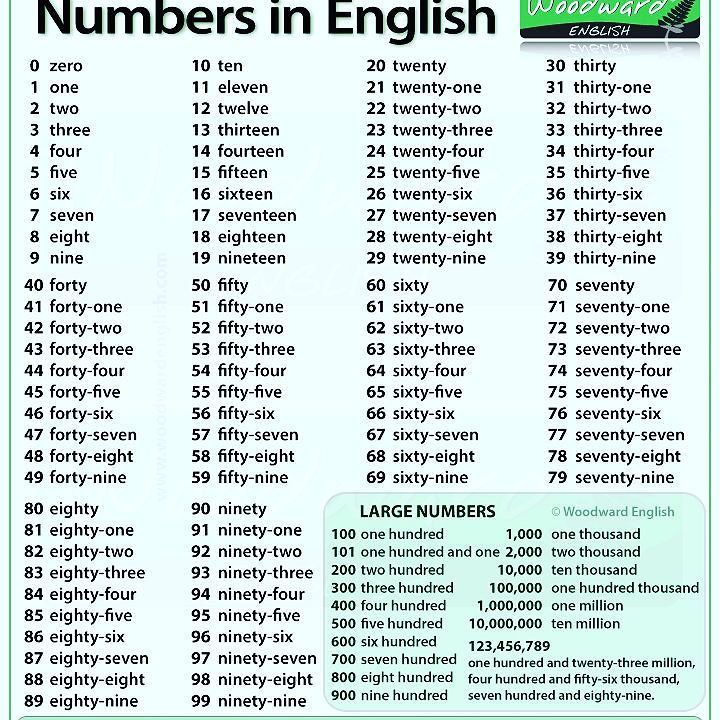 The numbers after the letter "C" indicate the load index through a slash. The first number of this designation on the tire indicates the possibility of maximum force with a single load, the second - with a double installation.
The numbers after the letter "C" indicate the load index through a slash. The first number of this designation on the tire indicates the possibility of maximum force with a single load, the second - with a double installation.
The ability to operate at certain speeds is indicated on the side with the letters of the English alphabet. This parameter is specified taking into account the maximum load. That is, it will be completely safe to accelerate to maximum values \u200b\u200bif the force described above acts on the product, indicated in kilograms or pounds.
| Speed index | Speed, km/h |
|---|---|
| L | 120 |
| M | 130 |
| N | 140 |
| P | 150 |
| Q | 160 |
| R | 170 |
| S | 180 |
| T | 190 |
| H | 210 |
| V | 240 |
| W | 270 |
| Y | 300 |
| Z | >300 |
Information about the manufacturer, place of production, size, production date of the tire and confirmation that this tire is certified is indicated in the DOT code. The DOT code is an alphanumeric sequence of characters consisting of two parts:
The DOT code is an alphanumeric sequence of characters consisting of two parts:
Exceeding the internal pressure limit may result in product rupture. If the car is moving at high speed, then this phenomenon can cause an accident with serious consequences.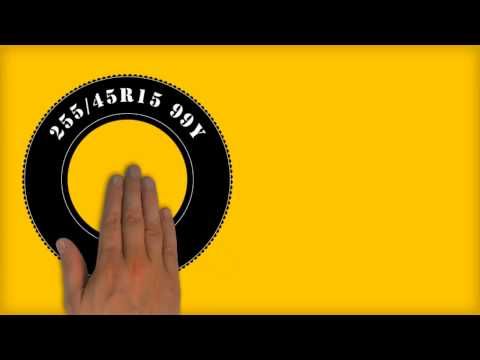 To ensure the safety of car operation, you should know to what maximum pressure the cylinder can be inflated. The type of designation for this parameter will depend on the country in which the part is manufactured. For US products, the PSI letter designation, which is expressed in pounds per square inch, is considered standard. Products from Russia are marked with a designation in kPa. More familiar to car owners from our country is the designation of 1 kgf / cm 2 , which is also called the technical atmosphere. This is due to the fact that on the pressure gauges installed in the pumps, the pressure is measured in these units. To find out the approximate value in technical atmospheres with the specified pressure limit in kPa, it is enough to divide this figure by 100.
To ensure the safety of car operation, you should know to what maximum pressure the cylinder can be inflated. The type of designation for this parameter will depend on the country in which the part is manufactured. For US products, the PSI letter designation, which is expressed in pounds per square inch, is considered standard. Products from Russia are marked with a designation in kPa. More familiar to car owners from our country is the designation of 1 kgf / cm 2 , which is also called the technical atmosphere. This is due to the fact that on the pressure gauges installed in the pumps, the pressure is measured in these units. To find out the approximate value in technical atmospheres with the specified pressure limit in kPa, it is enough to divide this figure by 100.
The M + S marking can be found on the side surface of the tire. The first letter is an abbreviation of the word Mud, which translates as "dirt". Similarly, you can interpret the letter S - Snow, "snow".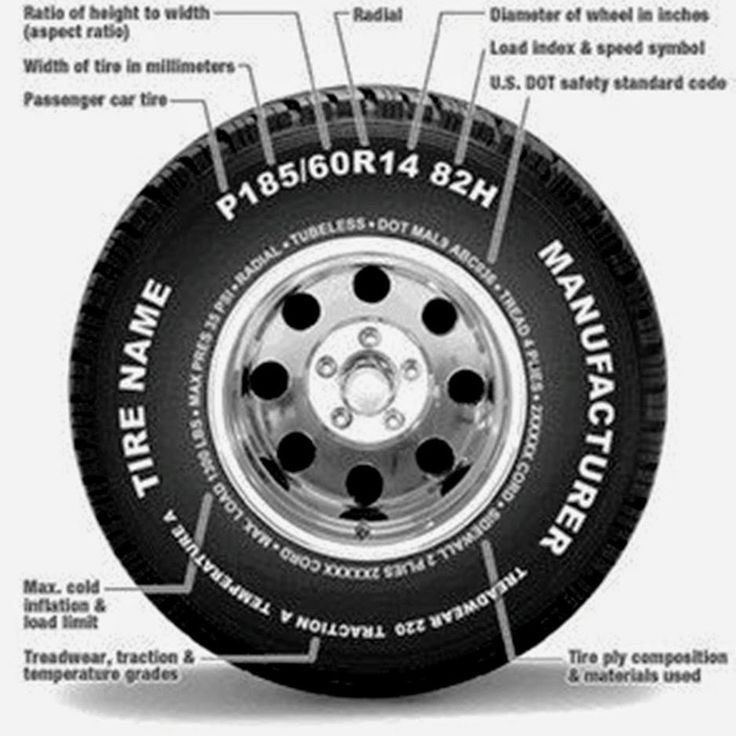 The presence of this designation indicates to the owner of the car the possibility of using the vehicle in conditions of severe pollution, including in the winter season. The ability to self-clean from dirt is also present in products designated as M + S.
The presence of this designation indicates to the owner of the car the possibility of using the vehicle in conditions of severe pollution, including in the winter season. The ability to self-clean from dirt is also present in products designated as M + S.
The ability to use a tire during a certain season is one of the most important parameters. The letter designation for the season may look like this:
Applicability under certain conditions can be indicated graphically. Many manufacturers put drawings in the form of a snowflake, sun or raindrops on the side of the product.
If the vehicle is operated in a humid climate, then a product should be selected that is specifically designed for use in such conditions.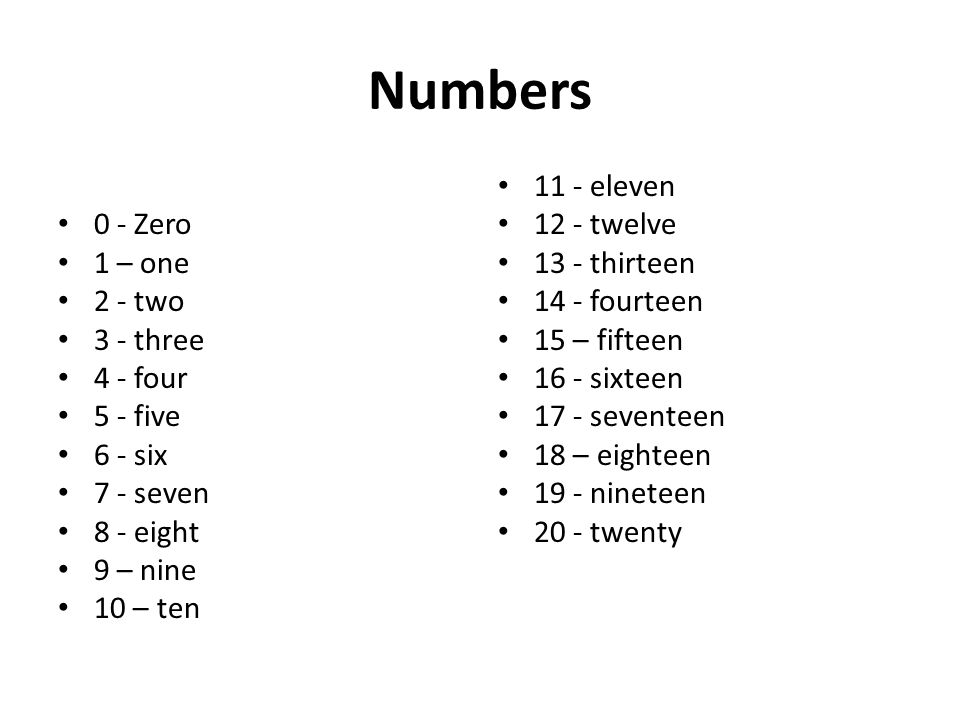 To ensure more efficient removal of fluid from under the contact patch, a protector is used, in which there are special channels. Products of this type can be referred to as Aquatred, Aquacontact, Rain, Water, Aqua. The graphic designation on the tire in the form of an umbrella also indicates that the part belongs to this category.
To ensure more efficient removal of fluid from under the contact patch, a protector is used, in which there are special channels. Products of this type can be referred to as Aquatred, Aquacontact, Rain, Water, Aqua. The graphic designation on the tire in the form of an umbrella also indicates that the part belongs to this category.
Depending on the size of the tire, it can be used for installation on cars or trucks. There are also a large number of intermediate types, which are also divided according to the possibility of use on certain types of vehicles. The letter difference in size is indicated as follows:
Tires made in the USA may have special indexes after the size. The following symbols can be found on such products:
 Indicates the ability to maintain performance under high heat. The temperature index can be as follows: A, B, C. The best indicator is A.
Indicates the ability to maintain performance under high heat. The temperature index can be as follows: A, B, C. The best indicator is A. Selecting the correct product according to the indexes will ensure optimal safety and driving performance in various conditions.
Some manufacturers use color codes on the surface of the product. The most commonly used colors for this purpose are white, red and yellow. Tire markings can be in the form of small circles or triangles.
If a geometric figure in red color is applied to the surface of the product, this indicates the presence of the hardest part of the tire, that is, the heaviest part. This type of color indicator allows you to correctly install the product on the disk.
The markings on tires in white indicate the presence of the most flexible section on the side.
Indicator yellow indicates the lightest point on the tire and must be aligned with the heaviest point on the rim.
The colored lines of can also be found on the tread. The lines are applied for the purpose of more convenient identification in the manufacturer's warehouse. These lines do not carry any technical information.
Manufacturers may indicate the degree of protection of the product from damage. Most often, the following tire marking is used for this purpose:
Additional protection provides a significant increase in service life even when used in harsh environments.
In addition to the main parameters, manufacturers often put additional information on the side part, which characterizes the product more accurately. We note the most common auxiliary designations on tires and their interpretation:
 The larger the first digit, the greater the load the product can be subjected to.
The larger the first digit, the greater the load the product can be subjected to. If the GOST or TU designations are applied to the tire, then a product of a domestic manufacturer can be installed on them. After the letter designation, the digital number of the state standard or technical specification is indicated.
Asymmetric rails can also be marked with additional markings, which can be used to determine the side of the product during installation work. On such products, the inner side is designated INSIDE , and the outer side is OUTSIDE .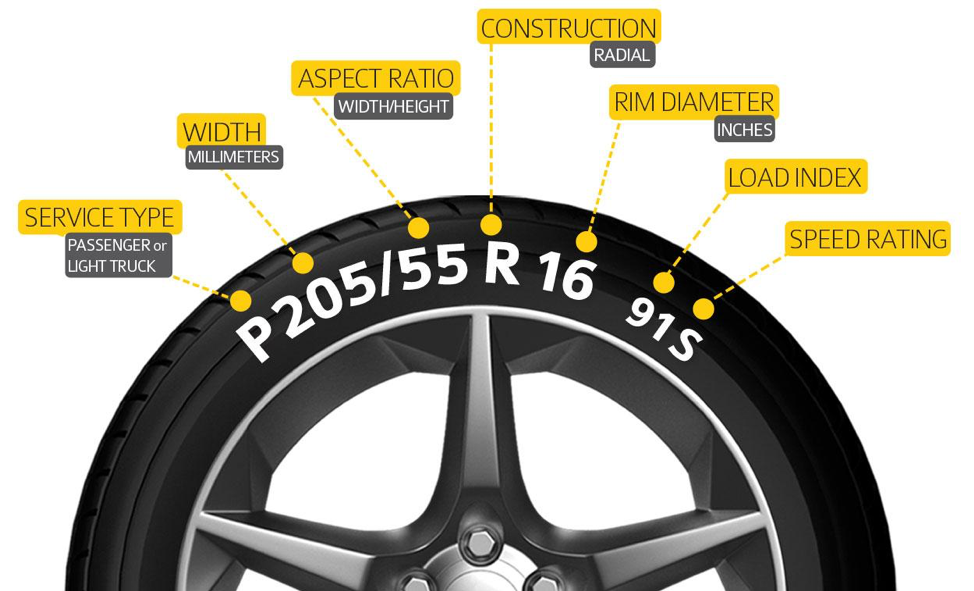
Direction of rotation is also important, so on most models you will see the word Rotation with an arrow.
Designation Rotation.Some tire manufacturers have original designations. To make an accurate decoding of the alphabetic, digital or graphic elements of the tire marking, just visit the official website of the company. On such resources, you can get comprehensive information not only about the coding of certain technical qualities of tires, but also learn about the features of their production and the materials used.
When selecting new tires yourself, it is recommended that the kit be of the same make and model. Even in the case when the products coincide in basic designations, they may differ in weight. The efficiency of drainage from the contact patch can also vary significantly, which increases the likelihood of hydroplaning when driving on a wet track. Dry grip coefficients can also vary significantly, which is manifested by uneven braking force.
When selecting new products, avoid fitting low profile products to the front axle and high profile products to the rear axle. If this rule is violated, the ground clearance of the car will be significantly reduced and the car will cling to the bottom of the bumps in the road.
Installing one set of tires will avoid skidding, reduce fuel consumption and improve driving comfort.
Information about the types of tires that can be fitted to the vehicle can be found directly on the vehicle. A table with the necessary instructions may be located on the A-pillar or on the door sill. In this way, you can also find out about the maximum allowable pressure for the rear and front cylinders.
When choosing a tire, all parameters are important, but first of all, you should pay attention to the following:
Tire load indexes and speed ratings are also very important if the vehicle is to be used in the most severe conditions.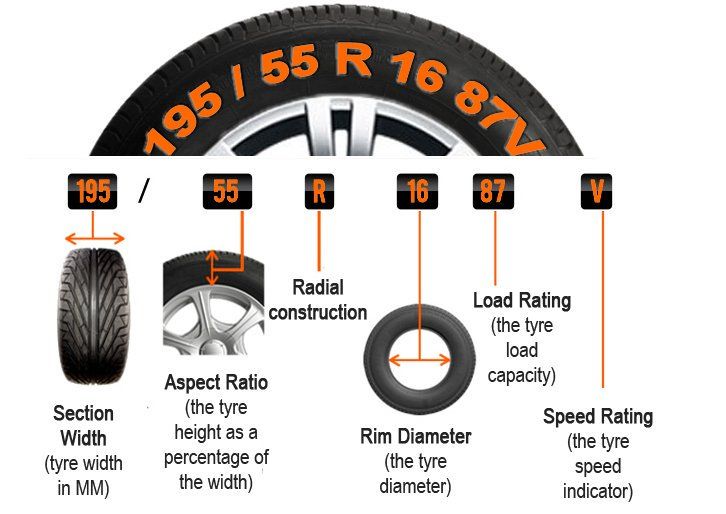
Many parameters have a direct impact on safety. If summer tires are used on a snowy track, this will cause skidding. Some of the functionality of the parameters is not so obvious. For example, with an increase in tire width, the likelihood of hydroplaning increases significantly even if the product tread has an effective drainage system from the contact patch with the road surface.
Deviations in parameters are allowed in some cases. For example, you can choose wheels with a slightly larger diameter and install a low-profile tire on them. This technical solution has some limitations. Despite the apparent simplicity of such an operation, the work should be entrusted to professionals. The possibility of tuning should also be discussed with qualified craftsmen before purchasing a new set of wheels.
If you have doubts about your own knowledge in the field of the correct selection of tires for a car and when decoding tire markings, then you should seek help from professionals.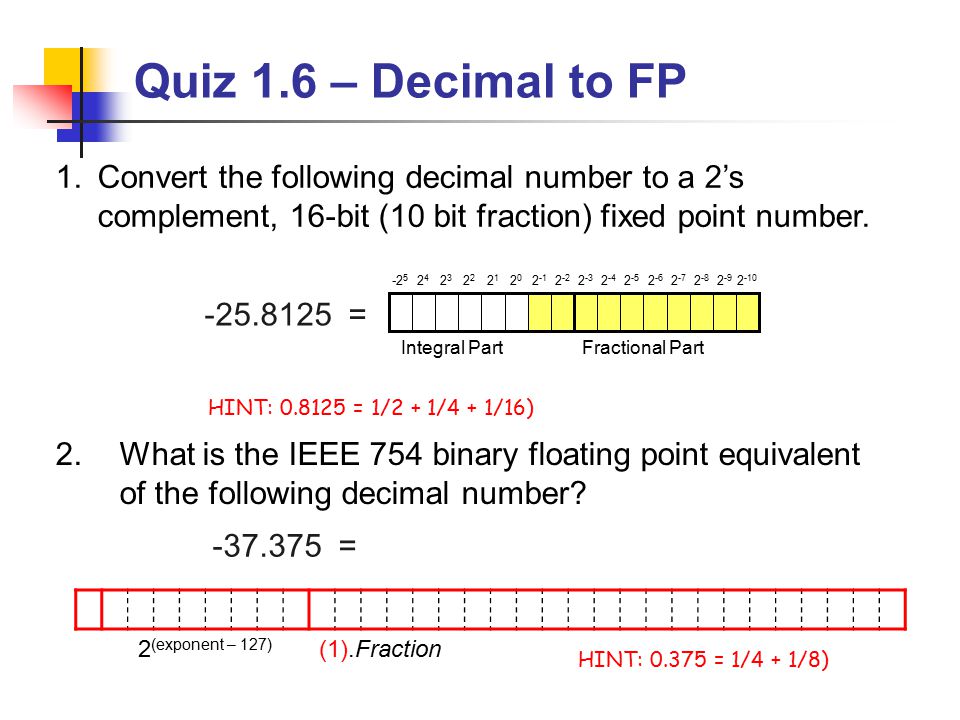 Many tire centers provide qualified advice when selecting products for a particular brand of car. With the right products selected and professional work done, tires will last as long as possible.
Many tire centers provide qualified advice when selecting products for a particular brand of car. With the right products selected and professional work done, tires will last as long as possible.
Choosing new tires is not an easy task, but if the buyer is provided with convenient functionality and a wide range of products, then this process becomes easier.
Vianor has a product catalog where you can find a new product for a specific car brand. Thus, even without knowledge of the main characteristics of the product and tire marking, you can make the right choice. It is enough to enter the car make, model and year of manufacture to purchase tires that will fully comply with the requirements of the vehicle manufacturer.
A wide range of tires allows you to choose a product that can be used in non-standard conditions. For example, you can buy tires and wheels for sports cars, as well as for heavy vehicles. Proper selection of products will ensure the safety of operation under increased loads and in various weather conditions. Products presented on the site have increased strength characteristics. The innovative rubber compound used in production can significantly reduce rolling resistance. Thus, it is possible to increase the level of comfort and reduce fuel consumption.
Products presented on the site have increased strength characteristics. The innovative rubber compound used in production can significantly reduce rolling resistance. Thus, it is possible to increase the level of comfort and reduce fuel consumption.
Convenient delivery to any region of Russia is also one of the company's advantages. The buyer is given the opportunity to independently pick up the previously ordered goods at the tire center, which is located at the place of his residence. If necessary, you can order delivery to the address that will be specified when placing the order.
Each client can call the contact center number and clarify information about the range of car tires and wheels on sale, the meaning of the marking parameters or the possibility of delivery of the selected product. You can pay for your purchase with a credit card or in cash upon receipt. If the goods will be collected independently from the tire center, it is recommended that you first make a call to the organization in order to clarify the non-cash payment.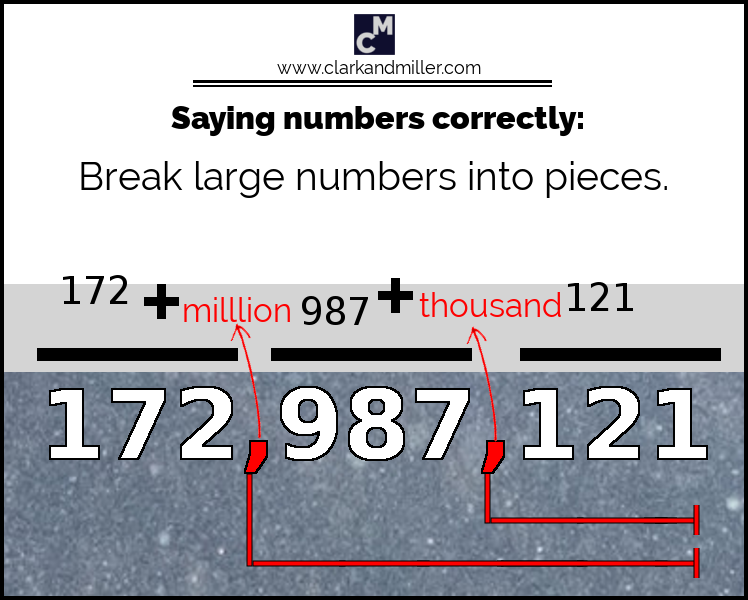
Vianor tires and wheels are of impeccable quality. Excellent performance characteristics allow you to provide an optimal level of comfort and safety. Managers of the company are ready to provide free consulting services for the selection of new products for a particular brand of car. In addition, on the site there is an opportunity to independently familiarize yourself with the range of products.
Do you want to choose a tire for your car, but do not understand tire markings well? It's not a problem! In this section, we will help you figure out what tire parameters are, what they mean, and which tire is right for your car.
Select tires / tire catalog
195/65 R15 91 T XL
195 is the tire width in mm.
65 - Proportionality, i.e.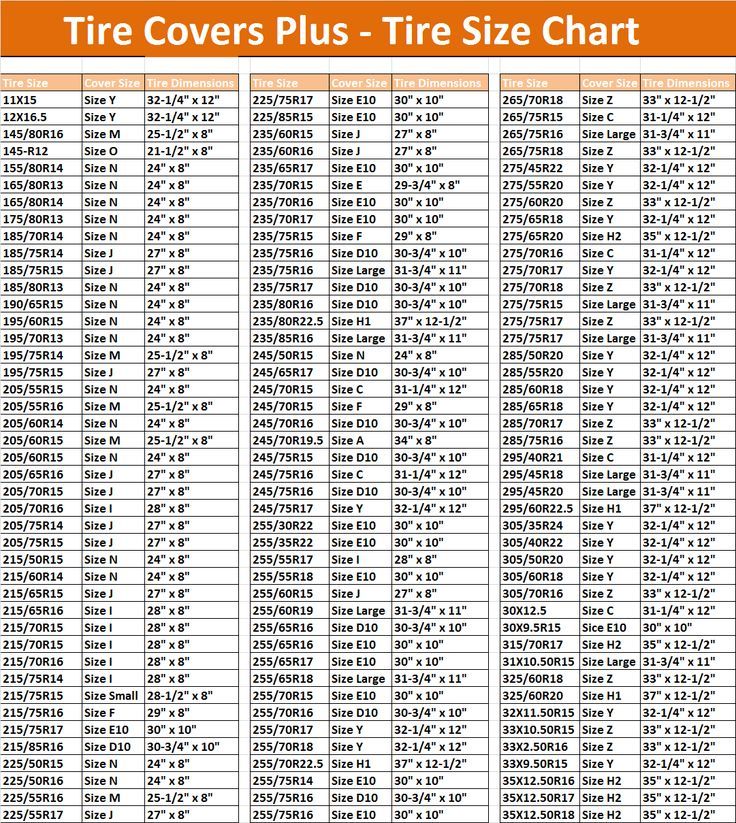 profile height to width ratio. In our case, it is equal to 65%. Simply put, with the same width, the larger this indicator, the higher the tire will be and vice versa. Usually this value is simply called “profile”.
profile height to width ratio. In our case, it is equal to 65%. Simply put, with the same width, the larger this indicator, the higher the tire will be and vice versa. Usually this value is simply called “profile”.
Since the tire profile is a relative value, it is important to take into account when choosing rubber that if you want to put tires with a size of 205/65 R15 instead of the size 195/65 R15, then not only the width of the tire will increase, but also the height! Which in most cases is unacceptable! (except when both of these sizes are indicated in the car's operating book). You can calculate the exact data on changing the outer dimensions of the wheel in a special tire calculator.
If this ratio is not specified (for example, 185/R14C), then it is equal to 80-82% and the tire is called full profile. Reinforced tires with this marking are usually used on minibuses and light trucks, where a large maximum wheel load is very important.
R - means a tire with a radial cord (in fact, almost all tires are made this way now).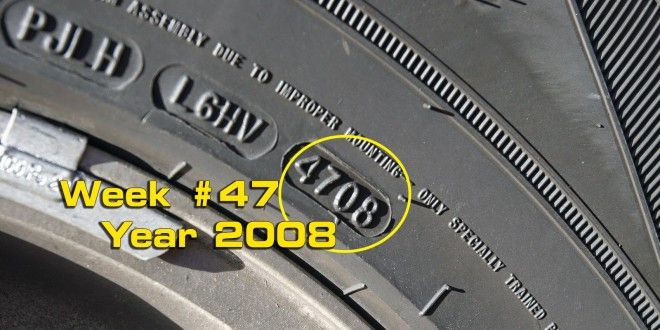
Many mistakenly believe that R- means the radius of the tire, but this is the radial design of the tire. There is also a diagonal design (indicated by the letter D), but recently it has practically not been produced, since its performance is noticeably worse.
15 - wheel (rim) diameter in inches. (It is the diameter, not the radius! This is also a common mistake). This is the “landing” diameter of the tire on the disk, i.e. is the inside size of the tire or the outside of the rim.
91 - load index. This is the level of maximum permissible load on one wheel. For passenger cars, it is usually done with a margin and is not a decisive factor when choosing tires (in our case, IN - 91 - 670 kg.). For minibuses and small trucks, this parameter is very important and must be observed.
T is the tire speed index. The larger it is, the faster you can ride on this tire (in our case, IS - H - up to 210 km / h). Speaking about the tire speed index, I would like to note that with this parameter, the tire manufacturer guarantees the normal operation of the rubber when the car is constantly moving at the specified speed for several hours.
Speaking about the tire speed index, I would like to note that with this parameter, the tire manufacturer guarantees the normal operation of the rubber when the car is constantly moving at the specified speed for several hours.
There are two different American tire markings. The first one is very similar to the European one, only the letters “P” (Passanger - for a passenger car) or “LT” (Light Truck - light truck) are placed before the size. For example: P 195/60 R 14 or LT 235/75 R15. And another tire marking, which is fundamentally different from the European one.
Example: 31x10.5 R15 (corresponds to European size 265/75 R15)
31 is the outside diameter of the tire in inches.
10.5 is tire width in inches.
R - a tire with a radial design (older tire models were with a diagonal design).
15 is the inner diameter of the tire in inches.
Generally speaking, except for inches that are unusual for us, the American tire marking is logical and more understandable, unlike the European one, where the height of the tire profile is not constant and depends on the width of the tire. And here everything is simple with decoding: the first digit of the standard size is the outer diameter, the second is the width, the third is the inner diameter.
XL or Extra Load is a reinforced tire, the load index of which is 3 units higher than that of conventional tires of the same size. In other words, if a given tire has a load index of 91 marked XL or Extra Load, then this means that with this index, the tire is able to withstand a maximum load of 670 kg instead of 615 kg (see the table of tire load indices).
M+S or tire marking M&S (Mud + Snow) - mud plus snow and means that the tires are all-season or winter. Many summer tires for SUVs are labeled M&S. However, these tires must not be used in winter, as winter tires have a completely different rubber compound and tread pattern, and the M&S badge indicates good flotation performance.
Many summer tires for SUVs are labeled M&S. However, these tires must not be used in winter, as winter tires have a completely different rubber compound and tread pattern, and the M&S badge indicates good flotation performance.
All Season or AS all season tires. Aw (Any Weather) - Any weather.
Pictogram * (snowflake) — rubber is designed for use in harsh winter conditions. If this marking is not on the sidewall of the tire, then this tire is intended for use only in summer conditions.
Aquatred, Aquacontact, Rain, Water, Aqua or icon (umbrella) Special rain tyres.
Outside and Inside ; asymmetric tires, i.e. It is important not to confuse which side is the outside and which is the inside. When installing, the Outside inscription must be on the outside of the car, and Inside on the inside.
RSC (RunFlat System Component) - RunFlat tires are tires on which you can continue to drive a car at a speed of no more than 80 km / h with a FULL tire pressure drop (due to a puncture or cut).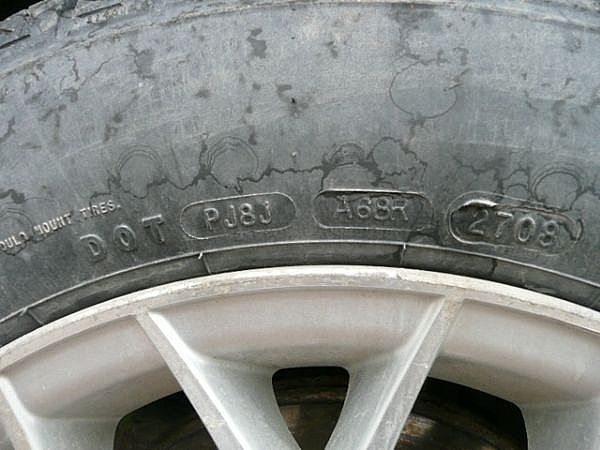 On these tires, depending on the manufacturer's recommendations, you can drive from 50 to 150 km. Different tire manufacturers use different designations for RSC technology. For example: Bridgestone RFT, Continental SSR, Goodyear RunOnFlat, Nokian Run Flat, Michelin ZP etc.
On these tires, depending on the manufacturer's recommendations, you can drive from 50 to 150 km. Different tire manufacturers use different designations for RSC technology. For example: Bridgestone RFT, Continental SSR, Goodyear RunOnFlat, Nokian Run Flat, Michelin ZP etc.
Rotation or arrow This marking on the tire sidewall indicates a directional tire. When installing the tire, you must strictly observe the direction of rotation of the wheel, indicated by the arrow.
Tubeless - tubeless tire. In the absence of this inscription, the tire can only be used with a camera. Tube Type - indicates that this tire must be used only with a tube.
Max Pressure ; maximum allowable tire pressure. Max Load - the maximum allowable load on each wheel of the car, in kg.
Reinforced or the letters RF in the size (for example 195/70 R15RF) means that this is a reinforced tire (6 layers). The letter C at the end of the size (for example 195/70 R15C) indicates a truck tire (8 layers).
Radial this marking on the rubber in the standard size means that it is a radial construction tire. Steel means that there is a metal cord in the tire structure.
Letter E (in a circle) - the tire meets the European requirements of ECE (Economic Commission for Europe). DOT (Department of Transportation - US Department of Transportation) is an American quality standard.
Temperature A, B, or C Temperature resistance of the tire at high speeds on the test bench (A is the best).
Traction A, B, or C
Treadwear ; relative expected mileage compared to a specific US standard test.
TWI (Tread Wear Indiration) - tire tread wear indicators. The marking on the TWI wheel can also be with an arrow. Pointers are located evenly in eight or six places around the entire circumference of the tire and show the minimum allowable tread depth. The wear indicator is made in the form of a protrusion with a height of 1.